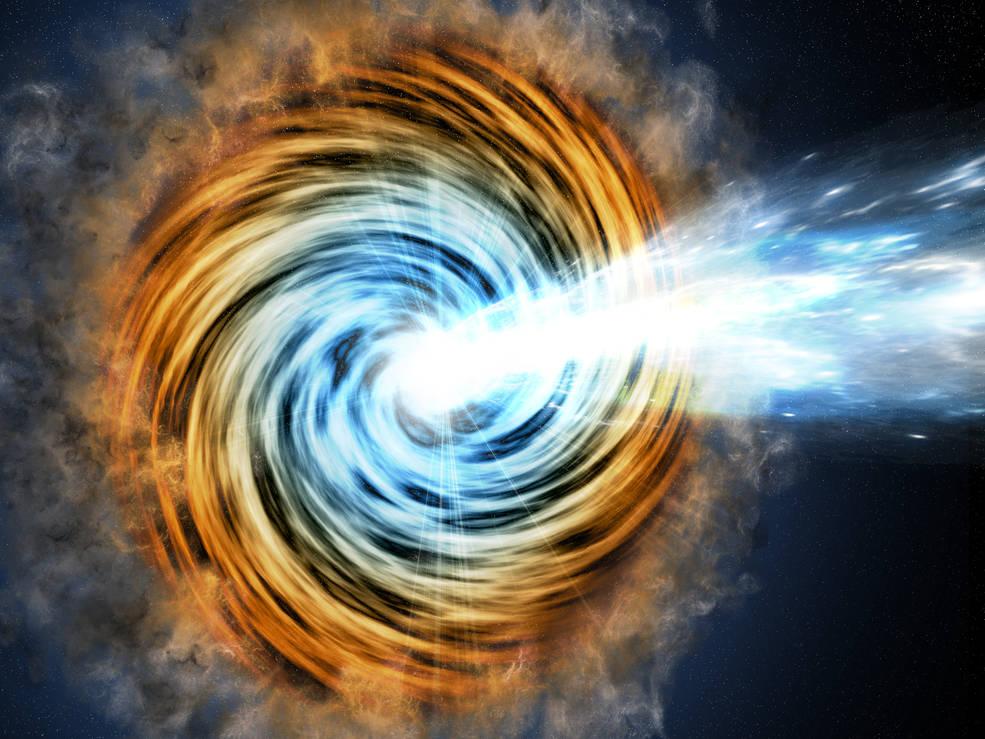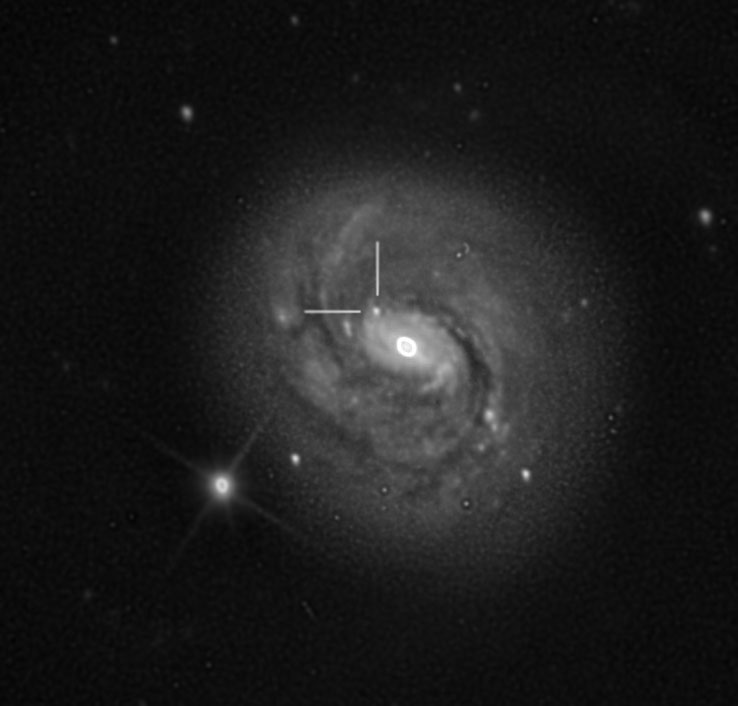|
Multi-messenger Astronomy
Multi-messenger astronomy is astronomy based on the coordinated observation and interpretation of disparate "messenger" signals. Interplanetary probes can visit objects within the Solar System, but beyond that, information must rely on "extrasolar messengers". The four extrasolar messengers are electromagnetic radiation, gravitational waves, neutrinos, and cosmic rays. They are created by different astrophysical processes, and thus reveal different information about their sources. The main multi-messenger sources outside the heliosphere are expected to be compact binary pairs (black holes and neutron stars), supernovae, irregular neutron stars, gamma-ray bursts, active galactic nuclei, and relativistic jets. The table below lists several types of events and expected messengers. Detection from one messenger and non-detection from a different messenger can also be informative. Networks The Supernova Early Warning System (SNEWS), established in 1999 at Brookhaven National Labor ... [...More Info...] [...Related Items...] OR: [Wikipedia] [Google] [Baidu] |
Astronomy
Astronomy () is a natural science that studies celestial objects and phenomena. It uses mathematics, physics, and chemistry in order to explain their origin and evolution. Objects of interest include planets, moons, stars, nebulae, galaxies, and comets. Relevant phenomena include supernova explosions, gamma ray bursts, quasars, blazars, pulsars, and cosmic microwave background radiation. More generally, astronomy studies everything that originates beyond Earth's atmosphere. Cosmology is a branch of astronomy that studies the universe as a whole. Astronomy is one of the oldest natural sciences. The early civilizations in recorded history made methodical observations of the night sky. These include the Babylonians, Greeks, Indians, Egyptians, Chinese, Maya, and many ancient indigenous peoples of the Americas. In the past, astronomy included disciplines as diverse as astrometry, celestial navigation, observational astronomy, and the making of calendars. ... [...More Info...] [...Related Items...] OR: [Wikipedia] [Google] [Baidu] |
Blazar
A blazar is an active galactic nucleus (AGN) with a relativistic jet (a jet composed of ionized matter traveling at nearly the speed of light) directed very nearly towards an observer. Relativistic beaming of electromagnetic radiation from the jet makes blazars appear much brighter than they would be if the jet were pointed in a direction away from Earth. Blazars are powerful sources of emission across the electromagnetic spectrum and are observed to be sources of high-energy gamma ray photons. Blazars are highly variable sources, often undergoing rapid and dramatic fluctuations in brightness on short timescales (hours to days). Some blazar jets exhibit apparent superluminal motion, another consequence of material in the jet traveling toward the observer at nearly the speed of light. The blazar category includes BL Lac objects and optically violently variable (OVV) quasars. The generally accepted theory is that BL Lac objects are intrinsically low-power radio galaxies while ... [...More Info...] [...Related Items...] OR: [Wikipedia] [Google] [Baidu] |
Baksan Neutrino Observatory
The Baksan Neutrino Observatory (BNO; Baksan is sometimes spelled Baxan) is a scientific laboratory of INR RAS located in the Baksan River gorge in the Caucasus mountains in Russia. Cleared for building in 1967, it started operations in 1977, becoming the first such neutrino observatory in the USSR. It consists of the Baksan Underground Scintillation Telescope (BUST), located below the surface, the gallium– germanium neutrino telescope (Soviet–American Gallium Experiment, SAGE) located 4,700 m.w.e. deep (2,100 meters) as well as a number of ground facilities. The Baksan Experiment on Sterile Transitions ( BEST) is currently (2019) being conducted at Baksan with aims of understanding sterile neutrinos. The laboratory itself is located in a 4,000 meter long horizontal tunnel mined specifically for this purpose; this is in contrast to most underground physics laboratories which are placed in abandoned or still in-use mines. The entrance of the tunnel is at a valley at 1,700 ... [...More Info...] [...Related Items...] OR: [Wikipedia] [Google] [Baidu] |
Irvine–Michigan–Brookhaven (detector)
IMB, the Irvine-Michigan-Brookhaven detector, was a nucleon decay experiment and neutrino observatory located in a Morton Salt company's Fairport mine on the shore of Lake Erie in the United States 600 meters underground. It was a joint venture of the University of California, Irvine, the University of Michigan, and the Brookhaven National Laboratory. Like several other particle detectors (see '' Kamiokande II''), it was built primarily with the goal of observing proton decay, but it achieved greater fame through neutrino observation, particularly those from Supernova SN 1987A. Design IMB consisted of a roughly cubical tank about 17 × 17.5 × 23 meters, filled with 2.5 million gallons of ultrapure water which was surrounded by 2,048 photomultiplier tubes. IMB detected fast-moving particles such as those produced by proton decay or neutrino interactions by picking up the Cherenkov radiation generated when such a particle moves faster than light's speed in water. Since dire ... [...More Info...] [...Related Items...] OR: [Wikipedia] [Google] [Baidu] |
Kamiokande
The is a neutrino and gravitational waves laboratory located underground in the Mozumi mine of the Kamioka Mining and Smelting Co. near the Kamioka section of the city of Hida in Gifu Prefecture, Japan. A set of groundbreaking neutrino experiments have taken place at the observatory over the past two decades. All of the experiments have been very large and have contributed substantially to the advancement of particle physics, in particular to the study of neutrino astronomy and neutrino oscillation. The mine The Mozumi mine is one of two adjacent mines owned by the Kamioka Mining and Smelting Co. (a subsidiary of the Mitsui Mining and Smelting Co. Mitsui Kinzoku'). The mine is famous as the site of one of the greatest mass-poisonings in Japanese history. From 1910 to 1945, the mine operators released cadmium from the processing plant into the local water. This cadmium caused what the locals called itai-itai disease. The disease caused weakening of the bones and extreme pai ... [...More Info...] [...Related Items...] OR: [Wikipedia] [Google] [Baidu] |
Supernova Neutrinos
Supernova neutrinos are weakly interactive elementary particles produced during a core-collapse supernova explosion. A massive star collapses at the end of its life, emitting of the order of 1058 neutrinos and antineutrinos in all lepton flavors. The luminosity of different neutrino and antineutrino species are roughly the same. They carry away about 99% of the gravitational energy of the dying star as a burst lasting tens of seconds. The typical supernova neutrino energies are 10–20 MeV. Supernovae are considered the strongest and most frequent source of cosmic neutrinos in the MeV energy range. Since neutrinos are generated in the core of a supernova, they play a crucial role in the star's collapse and explosion. Neutrino heating is believed to be a critical factor in supernova explosions. Therefore, observation of neutrinos from supernova provides detailed information about core collapse and the explosion mechanism. Further, neutrinos undergoing collective flavor c ... [...More Info...] [...Related Items...] OR: [Wikipedia] [Google] [Baidu] |
Solar Flare
A solar flare is an intense localized eruption of electromagnetic radiation in the Sun's atmosphere. Flares occur in active regions and are often, but not always, accompanied by coronal mass ejections, solar particle events, and other solar phenomena. The occurrence of solar flares varies with the 11-year solar cycle. Solar flares are thought to occur when stored magnetic energy in the Sun's atmosphere accelerates charged particles in the surrounding plasma. This results in the emission of electromagnetic radiation across the electromagnetic spectrum. High-energy electromagnetic radiation from solar flares is absorbed by the daylight side of Earth's upper atmosphere, in particular the ionosphere, and does not reach the surface. This absorption can temporarily increase the ionization of the ionosphere which may interfere with short-wave radio communication. The prediction of solar flares is an active area of research. Flares also occur on other stars, where the term ... [...More Info...] [...Related Items...] OR: [Wikipedia] [Google] [Baidu] |
Neutrino Astronomy
Neutrino astronomy is the branch of astronomy that observes astronomical objects with neutrino detectors in special observatories. Neutrinos are created as a result of certain types of radioactive decay, nuclear reactions such as those that take place in the Sun or high energy astrophysical phenomena, in nuclear reactors, or when cosmic rays hit atoms in the atmosphere. Neutrinos rarely interact with matter, meaning that it is unlikely for them to scatter along their trajectory, unlike photons. Therefore, neutrinos offer a unique opportunity to observe processes that are inaccessible to optical telescopes, such as reactions in the Sun's core. Neutrinos can also offer a very strong pointing direction compared to charged particle cosmic rays. Since neutrinos interact weakly, neutrino detectors must have large target masses (often thousands of tons). The detectors also must use shielding and effective software to remove background signal. History Neutrinos were first recorded ... [...More Info...] [...Related Items...] OR: [Wikipedia] [Google] [Baidu] |
Brookhaven National Laboratory
Brookhaven National Laboratory (BNL) is a United States Department of Energy national laboratory located in Upton, Long Island, and was formally established in 1947 at the site of Camp Upton, a former U.S. Army base and Japanese internment camp. Its name stems from its location within the Town of Brookhaven, approximately 60 miles east of New York City. It is managed by Stony Brook University and Battelle Memorial Institute. Research at BNL includes nuclear and high energy physics, energy science and technology, environmental and bioscience, nanoscience, and national security. The 5,300 acre campus contains several large research facilities, including the Relativistic Heavy Ion Collider and National Synchrotron Light Source II. Seven Nobel Prizes have been awarded for work conducted at Brookhaven Lab. Overview BNL is staffed by approximately 2,750 scientists, engineers, technicians, and support personnel, and hosts 4,000 guest investigators every year. The laboratory has it ... [...More Info...] [...Related Items...] OR: [Wikipedia] [Google] [Baidu] |
Tidal Disruption Event
A tidal disruption event (TDE) is an astronomical phenomenon that occurs when a star approaches sufficiently close to a supermassive black hole (SMBH) to be pulled apart by the black hole's tidal force, experiencing spaghettification. A portion of the star's mass can be captured into an accretion disk around the black hole (if the star is on a parabolic orbit), resulting in a temporary flare of electromagnetic radiation as matter in the disk is consumed by the black hole. According to early papers, tidal disruption events should be an inevitable consequence of massive black holes' activity hidden in galaxy nuclei, whereas later theorists concluded that the resulting explosion or flare of radiation from the accretion of the stellar debris could be a unique signpost for the presence of a dormant black hole in the center of a normal galaxy. Sometimes a star can survive the encounter with an SMBH, and a remnant is formed. These events are termed partial TDEs. History Physicist Joh ... [...More Info...] [...Related Items...] OR: [Wikipedia] [Google] [Baidu] |
Messier 77
Messier 77 or M77, also known as NGC 1068 and the Squid Galaxy, is a barred spiral galaxy about 47 million light-years away in the constellation Cetus. Messier 77 was discovered by Pierre Méchain in 1780, who originally described it as a nebula. Méchain then communicated his discovery to Charles Messier, who subsequently listed the object in his catalog. Both Messier and William Herschel described this galaxy as a star cluster. Today, however, the object is known to be a galaxy. The morphological classification of NGC 1068 in the De Vaucouleurs system is (R)SA(rs)b, where the '(R)' indicates an outer ring-like structure, 'SA' denotes a non-barred spiral, '(rs)' means a transitional inner ring/spiral structure, and 'b' says the spiral arms are moderately wound. Ann et al. (2015) gave it a class of SAa, suggesting tightly wound arms. However, infrared images of the inner part of the galaxy reveal a prominent bar not seen in visual light, and for this reason it is now ... [...More Info...] [...Related Items...] OR: [Wikipedia] [Google] [Baidu] |





